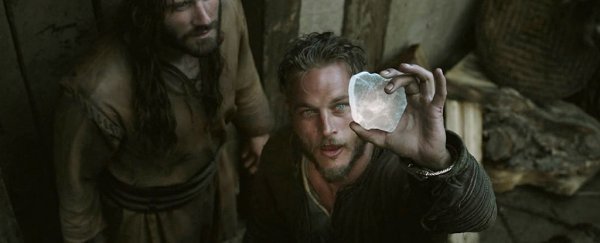For half a century, historians have wondered if Viking sailors travelled long distances under dense cloud cover under the guidance of a crystal called a sunstone.
Conclusive evidence might be forever buried in the past, but a new study details the kinds of conditions ancient mariners might have used this tool, demonstrating it was possible for Vikings to navigate through fog using little more than a polarising rock and some mathematical know-how.
Research conducted by Eötvös Loránd University in Hungary evaluated several types of polarising crystal under a range of meteorological conditions throughout the year to test a hypothesis first proposed back in 1967.
According to Danish archaeologist Thorhild Ramskou, Vikings managed to pinpoint the Sun's position through cloud cover by holding up a birefringent material – such as crystallised calcium carbonate called Iceland Spar – to filter the polarised light.
Sunlight passing through the translucent object might then be used in conjunction with a solar compass to work out the relative time and direction, which would aid in determining a position on a map.
It was a convenient solution to the mystery surrounding the journey of ancient Scandinavian seafarers to destinations as far away as North America.
Under perfect conditions the Sun, stars, marine life, and coastal features could be enough to mark off the milestones needed to navigate such epic treks across the expanse of an ocean.
The thing is, the conditions up around the icy North Atlantic aren't always ideal. If the rolling expanses of fog don't make life inconvenient for the navigator, the frequent cloud cover will certainly create problems.
That might be less of an issue if they'd had magnetic compasses to point to the poles, but there's no evidence Vikings possessed such technology.
There is mention of objects called "solar stones" in various medieval texts, however.
While historical writings hint at their use in locating the Sun through the clouds, they don't tend to provide many details on exactly how they were used.
Ramskou was the first modern academic to suggest these objects were crystals that could detect the Sun's precise position based on their refraction of polarised light.
As sunlight hits materials in the atmosphere, such as drops of water vapour, it scatters, making it all but impossible to tell the Sun's position.
Luckily the orientation of the scattered light is slightly different to the sunlight that slips through the clouds. By rotating a polarising filter in front of the eyes, it's possible to map the sky's brightness and trace the Sun's location.
Birefringent materials split incoming light into two, giving a sort of double image. The intensity of each image will vary, depending on the angle and polarisation of the light source.
It's not quite as simple as holding up a rock to unveil the Sun hiding behind the fog, requiring some careful calibration and a keen eye.
The hypothesis has plenty of supporters, even if it's a little short on hard evidence. No confirmed samples of sunstone have been uncovered, for instance, and only a single fragment of a potential Viking-age solar compass has ever surfaced.
To help fill in a few details on what is a highly speculative proposal, the Hungarian researchers tested three types of birefringent crystal under 1,080 variations of Sun angle and degrees of cloud cover set under laboratory conditions in a planetarium.
Calcite, cordierite, and tourmaline crystals were all up to the task of determining the angle of the Sun's elevation, especially at times close to dawn and dusk. On average, calcite was found to be the most accurate.
At some times of the year, such as summer solstice or spring equinox, and at particular elevations and cloud covers, tourmaline and cordierite produced in smaller uncertainties.
These results highlight the ideal conditions sunstones could have been used, and the degree of uncertainties they'd produce.
In short, if the Vikings used birefringent crystals at all, they would have found them most useful when the Sun was relatively low in the sky near summer solstice, perhaps around early to mid morning, when it's obscured by low level fog or cloud cover.
That's far from proof the Norse navigators used them at all. The data was also collected on solid ground inside a room, and not out on the rolling seas.
But nothing in the research rules out the possibility at least, adding a degree of credibility to the hypothesis that Vikings ruled the icy Atlantic waves with a sword in one hand and a gem in the other.
This research was published in the Proceedings of the Royal Society A.
